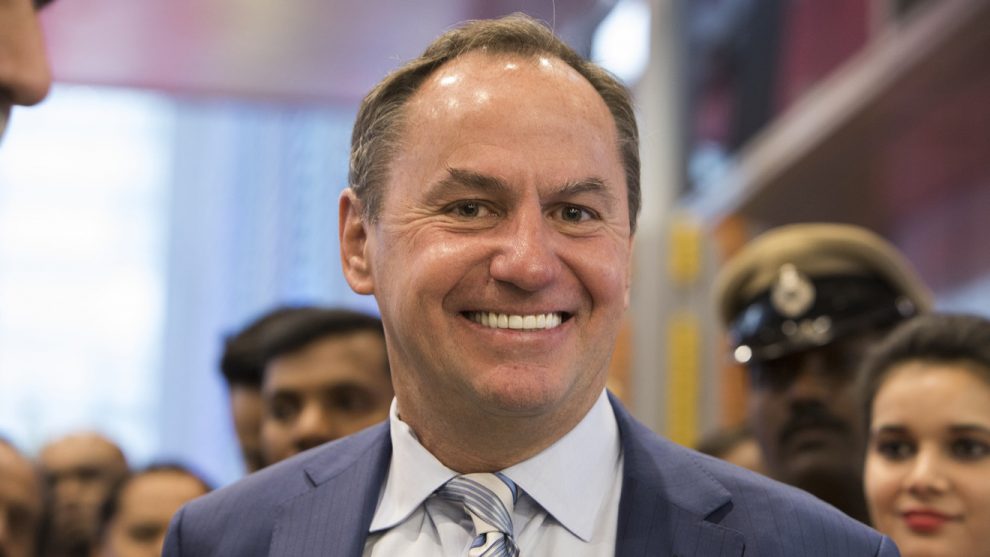
Intel Corp.’s new chief executive officer Bob Swan pulled off the band-aid to reveal some of the chip giant’s issues Thursday, and now investors have to hope he can solve them and get on a better path.
Intel INTC, -1.89% reported first-quarter earnings and revenue Thursday that exceeded some estimates, even amid a steepening decline in its important data-center business. But that business and more memory-chip price declines led Swan — in his first earnings report since being named the permanent CEO — to lower Intel’s revenue guidance for the rest of the year by a whopping $2.5 billion.
“The decline in memory pricing has intensified, the data-center inventory and capacity digestion that we described in January is more pronounced than we expected, and China headwinds have increased, leading to a more cautious IT spending environment,” Swan said on the company’s call with analysts, followed by a statement of confidence that demand will improve in the second half, based on customer conversations.
Don’t miss: The promise of a magical rebound for tech comes with little evidence to back it up
Intel’s shares tumbled about 7% in after-hours trading. So far this year, the stock is up about 25%, while the S&P 500 Index SPX, -0.04% is up about 17% year to date. Its sharply lower guidance comes on the heels of Intel’s big announcement last week that it would exit the 5G modem business, where its biggest customer for its communications chips was Apple Inc. AAPL, -0.91% . Swan told the Wall Street Journal that Intel’s decision was a direct result of Apple’s surprise settlement with Qualcomm Inc. QCOM, -2.03% , as a jury trial on their patent and royalty dispute was starting.
Swan continued to pare down Intel’s previous ambitions Thursday, noting that Intel has been trying to become more focused by exiting businesses that did not fit in with its core, such as shutting down Saffron, a cognitive computing platform Intel acquired in 2015. Swan seemed to be undoing bad moves by previous leaders, without naming any names.
“Over the last couple years, that focus has resulted in exiting McAfee and the wearables business, shutting down Saffron and divesting Wind River. And our spending as a percentage of revenue has gone from approximately 36% to about 30% this quarter,” he said. “By doing fewer things, we’ll execute better at the things that matter most.”
The last few CEOs before Swan have indeed made many moves to take Intel into new directions — spending billions on communications and mobile chip acquisitions, and billions more on seemingly ill-suited moves in software — to diversify beyond its core PC business. But so far it seems to have done the best with its acquisition of Mobileye, which develops vision-based advanced driving systems, and had record revenue growth of 38%.
See also: Chip stocks snap six-session record run, as Xilinx drops after earnings
It is probably a good thing for Intel to drop ambitions that are costing too much while not providing a return, but it still has to figure out how to succeed with the businesses it will keep. Another issue hurting the company is that its PC business has been hampered because it was not able to meet all the demand for its chips, as it has struggled in its transition to a new manufacturing node. “We’ve committed never again to be a constraint on our customers’ growth,” Swan said. “We’ve increased capacity to improve our position in the second half, although product mix will continue to be a challenge in the third quarter as our teams align available supply with customer demand.”
In the first quarter, Intel said its data-centric revenue was $7.5 billion, down 5%, while its data-center group ended the quarter with revenue at $4.9 billion, down 6%. Intel said it expects to see revenue in its data-centric business — its most important growth business — continue to decline in the high single digits.
Investors will be watching to see if Swan’s predictions of a better second half, especially for the data-center group, will hold true. Swan said the company’s first in a series of new chips based on its long-delayed next-generation manufacturing process are expected to be in consumer products “on the shelf for the holiday season,” with chips for servers to follow in 2020.
Memory prices and a continued slowdown in the data center build-out are clouds that will continue to hang over Intel and other chip makers for months. At least Swan got rid of some other headaches as he deals with those.
Want this type of analysis sent to your inbox? Subscribe to MarketWatch’s free MarketWatch First Takes newsletter. Sign up here.





